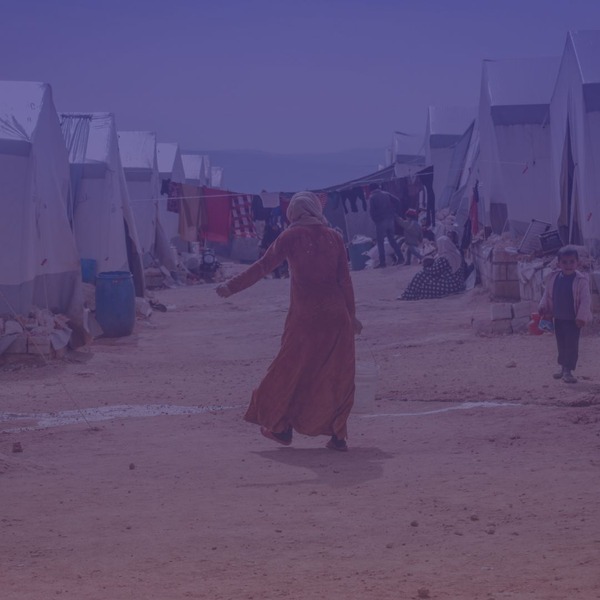
Written by: Bernat Baena, EST Ambassador to Spain
Edited by: Anca Grigoriescu
Crossing borders again: A forced return to a house on ruins
The Syrian conflict, which began in 2011 with peaceful protests against the al-Assad government repression, escalated into a brutal civil war involving numerous local, regional, and international actors. Over the years, Syria became a battleground for competing interests, leading to widespread destruction and one of the largest refugee crises of modern times.
After 14 years of conflict, President Bashar al-Assad’s rule over Syria collapsed at the end of 2024. In that time, hundreds of thousands were killed or injured, with more than 13 million people forced to abandon their homes, 6 million of them living as refugees in other countries (UNHCR, 2025). Now, with the fall of the regime, some Syrians are starting to return. But most are facing a devastating truth: they no longer have homes to return to.
While neighbouring countries and the European Union begin to pressure for Syrians to go back, the reality is that they are being sent to a place that no longer resembles home . These returns are happening to a country still in ruins, where houses are destroyed, jobs are lacking, and basic services remain limited, amid uncertainty over how Hay’at Tahrir al-Sham (HTS), a dominant militant group in northwest Syria that emerged from al-Qaeda, will take shape.
In this context, it is pressing to examine how Syrian refugees have rebuilt their lives in exile, the forced return pressured by the receiving states, and the consequences of sending people back to instability. The Syrians return to a country in ruins may trigger a dangerous cycle of renewed displacement and further humanitarian crisis.
The war and the displacement
Leaving one’s country is always a difficult choice, even for those that are living under a civil war. It means leaving everything you have built behind and starting again, facing uncertainty and a risk, with no guarantee of success. Since the conflict began 14 years ago, more than 1.3 million Syrians have sought protection in Europe, 2.9 million in Turkey, 755.000 in Lebanon and 611.000 in Jordan (Norman & Gil, 2025). The living conditions far from home are not much better as 87% of Syrians in neighbouring countries said their income is not enough to meet their basic needs (Todman, 2024). In countries like Lebanon, Syrians have accepted precarious jobs in construction, working more than 60 hours a week and being paid less than the Lebanese (Kanaana, 2015). These situations created tensions with home citizens who fear their jobs can be taken by Syrians who accept these conditions in order to survive.
In 2014, Turkish authorities gave Syrians universal access to health care, education and the right to work though recognising them under temporary protection (Guzel & Fraser, 2024). This contributed to the number of Syrians in Turkey reaching a peak of 3.8 million by 2022. Mahmut Cabuli, a Syrian refugee in Turkey that spent several years in a refugee camp before finding a job at a textile factory, argues that they can’t return to a country where “There’s no work, electricity, or water. There’s no leader” (Guzel & Fraser, 2024). Like thousands of other refugees, Cabuli has rebuilt his life and after suffering several years under harsh conditions has found stability: “My children were born here. I am working, thank God. I am happy here. I don’t want to go back now,” he said (Guzel & Fraser, 2024). Still, like in Lebanon, Syrians in Turkey have faced the same pressures as in Lebanon, with Turks accusing them of taking their jobs and straining health care and other public services, leading to increased tensions and riots (Guzel & Fraser, 2024).
In both Turkey and Lebanon, Syrians have been forced to leave the country over the years through policies of marginalisation and forced deportation, with 84% of the Syrian families living in extreme poverty in 2023 (Norman & Gil, 2025). Moreover, recent conflicts between Hezbollah and Israel in Lebanon have forced more than 425.000 Syrians to flee once again from yet another conflict (Norman & Gil, 2025).
Meanwhile, European countries have received more than 1.3 million Syrians, with 780,000 holding refugee status or subsidiary protection, and the rest granted long-term residency or citizenship. In this context, the legal status granted is not arbitrary, as it adheres to the Geneva Convention (Norman & Gil, 2025). However, the same convention that once offered them safety and the opportunity to rebuild their lives is now being interpreted in ways that could justify sending them back to Syria. This is because countries only have the legal obligations to assist refugees if they consider that there’s a threat in their country. As Al-Assad is gone, European countries are starting to consider that the danger is over (Norman & Gil, 2025).
Pressured to leave: The politics of return
These past years, host states have shown increasing fatigue toward receiving Syrians fleeing the atrocities committed by the al-Assad regime. In Europe, recognition rates for refugee status declined from 81% in 2015 to 68% in 2023 (Norman & Gil, 2025). As stated in the Geneva Convention Relating to the Status of Refugees, EU law permits governments to revoke, end or refuse to renew the refugee status if the grounds for protection no longer apply.
In Austria, shortly after al-Assad was forced to leave Syria, there were announcements of plans to deport Syrians back to their country. A dozen European countries followed the lead announcing the cessation of processing Syrians’ asylum claims (Todman, 2024). The collapse of the regime has given those countries an opportunity to send Syrians back, arguing that protection is no longer necessary.What EU countries seem to forget is that “In wartime, people flee their homes not only because they fear violence, but because they lack infrastructure, services and jobs” (Seven, 2024).
Hasan Alzagher, a Syrian refugee interviewed by Reuters and living in Germany, saw his asylum application put on hold after the fall of the al-Assad government (Tagaris et al., 2024). Fearing he might be forced back to Syria after many years adapting to a new life, he stressed: “This is mentally devastating. It’s difficult that after you set your mind to live here, build a new life here, learn the language and integrate in this country, you now have to return to your homeland where basic necessities are still missing” (Tagaris et al., 2024). The UNHCR has stated that Syrians should still be granted refugee status, as they need protection (Norman & Gil, 2025)
Thousands of Syrians are in the same situation as Hasan Alzagher. These are people who fought hard to rebuild their lives after being forced out of their country due to widespread violence, destruction, and loss of life, are being “forced” back to a country where one third of the housing, along with half of the medical and educational facilities have been destroyed (Seven, 2024). Learning a new language, adapting to a new culture and integrating as part the society of the receiving country is a long-lasting process that creates certain ties with a new “home”. What Syrians are being asked to do now is to abandon the safety of their new homes and return to the ruins of the ones they once fled as a result of war, repression and destruction (Seven, 2024).
In Turkey and Lebanon, public attitudes have also shifted from initial hospitality to increasing hostility, with a rise of anti-refugee sentiment, especially due to persistent inflation and youth unemployment in Turkey (Guzel & Fraser, 2024). While Turkish President Erdoğan has stated that Syrians should return home according to their timeline, the Victor Party – a right-wing party in Turkey – has stated that “this prolonged stay under temporary protection must end” (Guzel & Fraser, 2024). Amid rising tensions, it appears increasingly likely that Syrians will be sent back, but not because they want to. It will be a forced return.
A country in ruins: The consequences of a forced return.
When governments and the public opinion talk about getting those migrants back to their land, they sometimes don’t consider where they are going back to and the consequences that another internal crisis in Syria could have. Accelerating the return of millions of Syrians without first making sure that basic economic, social and infrastructure conditions are met could backfire (Todman, 2024).
Although the state violence has ceased, Syrians are reluctant to return because of the lack of jobs and basic services. The lack of trust among parts of the population toward the HTS, which is affiliated with al-Qaeda and designated as a terrorist organization by several governments, also contributes to the issue, as some don’t see them capable of fixing the problems in a short-mid term without international assistance (Todman, 2024). With the current uncertainty, an overflow of refugees could collapse the available services, ending with another internal conflict and another refugee crisis, this time even worse.
Syrians that come back do not only have to consider a devastated economic situation, with an economic contraction of the 80% and a poverty rate of 90%, but also the housing situation (Levant24, 2025). In 2024, more than half of the population was in need of essential humanitarian assistance lacking shelter and other basic means of survival. (Norman & Gil, 2025). During the al-Assad regime, the Alawite minority and others received property transfers as symbols of loyalty towards the regime, leaving thousands without a home (Norman & Gil, 2025). Now, with one third of the housing destroyed and finding it difficult to prove property rights, some Syrians cannot return because they have nowhere to stay.
Moreover, international sanctions remain in place, preventing the entry of medications and equipments, with the international community still doubting the position towards the transitional government of HTS (Norman & Gil, 2025). As stated by Metin Corbatir, director of the Ankara-based Research Centre on Asylum and Migration, most of the departures are Syrians checking the situation back in their country, to assess if the conditions are fit for coming back.
Conclusions: what should the international community do?
Abu Abbas, father of five children and local of Ibtihal, was interviewed by UNHCR after coming back to Syria. “When I saw my home, it was in ruins. Life is truly painful – the necessities are missing. The sewage system is blocked. I don’t have the money to fix anything” (UNHCR, 2025). Millions are facing the same situation as Abu and his children.. If the international community wants Syrians to go back home and build a life there, the return can’t be forced. What needs to be done first is a reconstruction of a country whose infrastructure is destroyed, collaborate alongside the civil society and local governments to rebuild what used to be their home (Norman & Gil, 2025)
We should not forget that they didn’t leave because they wanted to. 13 million people were forced out of their homes under the threat of being killed by bombs, chemical attacks or torture under the al-Assad regime. People like Abu Abbas, Hasan Alzagher, or Mahmut Cabuli escaped to build a new life, so if host countries want them to go back a credible plan needs to be formulated together with humanitarian organisations (Guzel & Fraser, 2024). Although Western countries may experience donor fatigue, they must consider that if the country should collapse again, the costs would be much higher. People want to go back to their home, but if there’s not a place to go back to, and no solutions to ensure a life where the basic needs are covered, the return should not be rushed.
Bibliography
Guzel, M., & Fraser, S. (2024, December 29). Turkey’s push to send back Syrian refugees accelerates as Assad gains ground. AP News. https://apnews.com/article/turkey-syria-assad-erdogan-refugees-e5ea4587b0d010d5319667897a52ff51
Salwa Kanaana. (2015). Informally employed Syrian refugees working under harsh conditions. International Labour Organization https://www.ilo.org/resource/news/informally-employed-syrian-refugees-working-under-harsh-conditions-further
Levant 24. (2025, March). The road home: Syrian refugee returns. https://levant24.com/articles/2025/03/the-road-home-syrian-refugee-returns/
Norman, K., & Martín Gil, A. (2025). Assad’s fall opens window for Syrian refugees to head home – but for many, it won’t be an easy decision. The Conversation. https://theconversation.com/assads-fall-opens-window-for-syrian-refugees-to-head-home-but-for-many-it-wont-be-an-easy-decision-247051
Seven, Ü. (2024, December 22). Why Syrian refugees are unlikely to return home. The Loop. https://theloop.ecpr.eu/why-syrian-refugees-are-unlikely-to-return-home/
Tagaris, K., Karadeniz, B., & van Geyt, M. (2024, December 11). Syrian refugees in Europe fear being forced home after Assad’s fall. Reuters. https://www.reuters.com/world/europe/syrian-refugees-europe-fear-being-forced-home-after-assads-fall-2024-12-11/
Todman, W. (2024, February 1). Don’t rush Syrian refugees to return. Center for Strategic and International Studies. https://www.csis.org/analysis/dont-rush-syrian-refugees-return
UNHCR. (2025). Returning home to Syria: Four stories of hope for Syrian refugees. United Nations High Commissioner for Refugees. https://www.unrefugees.org/news/returning-home-to-syria-four-stories-of-hope-for-syrian-refugees/

 Human Rights Challenges in Addressing SLAPPs in Media, NGOs and Journalism in the EU
Human Rights Challenges in Addressing SLAPPs in Media, NGOs and Journalism in the EU  Defining European Citizenship: Its Significance and the EU’s Efforts to Foster Identity Through Education
Defining European Citizenship: Its Significance and the EU’s Efforts to Foster Identity Through Education  Shaping the future of healthcare: The European Union’s role in AI implementation
Shaping the future of healthcare: The European Union’s role in AI implementation  SEMICONDUCTORS AS KEY STRATEGIC ASSETS: NAVIGATING GLOBAL AND EUROPEAN SECURITY CHALLENGES
SEMICONDUCTORS AS KEY STRATEGIC ASSETS: NAVIGATING GLOBAL AND EUROPEAN SECURITY CHALLENGES 


